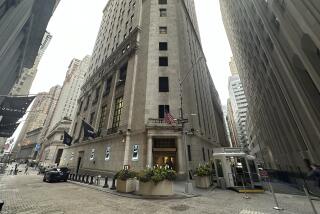Strong Dollar Could Add Up to 5-Digit Dow
- Share via
Dust off those Dow-10,000 party hats.
Enough investors finally got off the sidelines on Friday to propel the Dow Jones industrial average up 268.68 points to a record close of 9,736.08.
That convincingly topped the old Dow high of 9,643.32 set on Jan. 8. And Wall Street conveniently made the math easy: We need just one more day like Friday’s to cross the 10,000 mark. (A 264-point rise, or slightly more than 2.7%, to be exact.)
Can the Dow do it?
The U.S. dollar may hold the key. It’s strong worldwide, and getting stronger. And that has very important implications for stocks.
How so? Start with the inflation outlook. As the dollar buys more yen, deutsche marks and Brazilian real, the cost of imported goods declines. And Americans, of course, love imported goods--just look at our trade deficit.
What’s more, as imports continue to flood U.S. shores, the effect on U.S. manufacturers is to severely restrict their domestic pricing power, so that they remain competitive.
With import prices down and prices of many U.S. goods restrained, that’s a powerful depressant on inflation. Which, in turn, ought to help limit how high market interest rates can go, and keep the Federal Reserve Board from seizing any inflation excuse to tighten credit.
Take away the threat of higher interest rates, and you take away a major excuse people have been using to justify not buying stocks.
Perhaps even more important from the stock market’s view, the only way U.S. companies can meet the greater import threat posed by a strong dollar--and also keep their exports from being priced out of reach overseas by the dollar’s strength--is to launch new efforts to raise efficiency and productivity.
“If you’re going to be competitive in the world market, you have to get your pricing down,” noted James Glassman, economist at Chase Securities in New York. That is even more critical in a global economy which, except for the United States, is likely to grow anemically this year, he points out.
Last year, the fear was that U.S. corporate profits would increasingly be squeezed by higher labor costs (in the tightest labor market in decades) on one side and a lack of pricing power on the other. And in fact, profit growth was modest overall last year.
But look what’s happening now: The government’s measure of average wages inched up just 1 cent to $13.04 an hour in February. Over the last 12 months that figure has risen 3.6%--the slowest annualized rate of change in two years.
So even though many companies are having extraordinary trouble attracting workers, it isn’t translating into exploding wage growth. (Logical question: Is the number of companies giving stock options to rank-and-file workers, in lieu of cash raises, bigger even than what is suspected?)
It was the lack of wage inflation in Friday’s February employment report that helped push the bellwether 30-year Treasury bond yield down to 5.60% from Thursday’s seven-month high of 5.69%--and helped power the stock market’s surge.
Maybe the ultimate pressure on corporate profits from the labor market and the strong dollar will overwhelm the inflation benefits. But for now, this is what some Wall Street bulls are thinking: Strong dollar equals low price inflation equals rising productivity equals modest wage inflation equals lower interest rates equals a rising stock market.
*
Tom Petruno can be reached by e-mail at tom.petruno@latimes.com.
More to Read
Inside the business of entertainment
The Wide Shot brings you news, analysis and insights on everything from streaming wars to production — and what it all means for the future.
You may occasionally receive promotional content from the Los Angeles Times.










